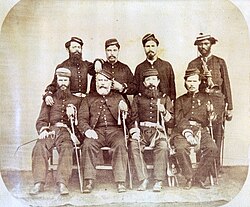The military ranks of the Empire of Brazil were a rank system used by the Armed Forces of the Empire of Brazil.
Contents

The military ranks of the Empire of Brazil were a rank system used by the Armed Forces of the Empire of Brazil.

The rank insignia of the Estado-Maior General (General/Flag officers) were established by an Imperial Decree of 7 October 1823. They bore the leaves of an Oak-tree, similar to the ranks of the Portuguese Army of the early 1800s. The ranks for the Senior and Junior Officers were the same throughout Pedro II's reign. [1]
In 1850, a law regulating the Promotion of officers in the Imperial Brazilian Army was approved. According to this legislation, to become an officer, one must have spent at least two years as a praça, and be at least 18 years old. This meant that to become an Alferes, equivalent to a 2º Lieutenant, one had to be either a Sergeant or a Cadet with service time at lower rankings, not to mention the students from the Escola Militar whose entrance to officership was handled by a separate legislation. To move up the rankings to Captain, the officer must have spent two years serving as a Tenente and two years as an Alferes. Promotion off Captain, after three years serving as one, would be as such: half of the officers promoted from Major to Coronel would be due to their service time, and the other for their accomplishments. On the other hand, promotion to the General Officers would only be granted for the accomplishments of the officer. [2]
For the Praças however, to achieve promotion was based on whether the praça had volunteered or had been conscripted. José Iran Ribeiro, from the Federal University of Santa Maria, found out that, from a group of 15 volunteers, 9 had risen up to become sergeants 6 of them before reaching 20 years of age. For 16 conscripts, promotion to sergeant was achieved by 5 of them, 3 of them after their 25th birthday. [3]
| Rank group | General / flag officers | Senior officers | Junior officers | |||||||||||||||||||||
|---|---|---|---|---|---|---|---|---|---|---|---|---|---|---|---|---|---|---|---|---|---|---|---|---|
| Epaulettes |  |  |  |  |  |  |  |  |  |  | ||||||||||||||
| Sleeve rank insignia |  |  |  |  |  |  |  |  |  |  |  | |||||||||||||
| Name [4] [5] [6] | Marechal de Exército | Tenente-general | Marechal de campo | Brigadeiro | Coronel | Tenente-coronel | Major | Capitão | Tenente | Alferes | Alferes-aluno | |||||||||||||

| Rank group | Senior NCOs | Junior NCOs | Enlisted | |||||||||||||||||||||||||||||||||
|---|---|---|---|---|---|---|---|---|---|---|---|---|---|---|---|---|---|---|---|---|---|---|---|---|---|---|---|---|---|---|---|---|---|---|---|---|
| Sleeve rank insignia [4] [7] |  |  |  |  |  |  |  | |||||||||||||||||||||||||||||
| Primeiro-sargento | Segundo-sargento | Furriel | Cabo | Anspeçada | Soldado | |||||||||||||||||||||||||||||||
| Rank group | General / flag officers | Senior officers | Junior officers | |||||||||||||||||||||
|---|---|---|---|---|---|---|---|---|---|---|---|---|---|---|---|---|---|---|---|---|---|---|---|---|
| Collar Rank insignia |  |  |  |  |  |  |  | |||||||||||||||||
| Name [8] [9] | Comandante Superior | Coronel Chefe de Legião | Tenente-coronel | Sargento-Major | Capitão | Tenente | Alferes | |||||||||||||||||
| Rank group | Senior NCOs | Junior NCOs | Enlisted | |||||||||||||||||||||||||||||||||
|---|---|---|---|---|---|---|---|---|---|---|---|---|---|---|---|---|---|---|---|---|---|---|---|---|---|---|---|---|---|---|---|---|---|---|---|---|
| Collar Rank insignia |  |  |  |  | ||||||||||||||||||||||||||||||||
| Sleeve rank insignia |  |  |  |  | ||||||||||||||||||||||||||||||||
| Names [8] | Primeiro-sargento | Segundo-sargento | Furriel | Cabo | ||||||||||||||||||||||||||||||||